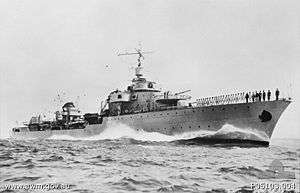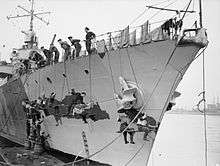French destroyer Le Triomphant
 pre-war view of Le Triomphant, showing crew manning the rails | |
| History | |
|---|---|
| Name: | Le Triomphant |
| Namesake: | "The triumphant one" |
| Builder: | Ateliers et Chantiers de France, Dunkerque |
| Laid down: | 18 August 1931 [1] |
| Launched: | 16 April 1934 [1] |
| Commissioned: | 25 May 1936 [1] |
| Decommissioned: | 6 December 1954 [1] |
| Reclassified: | March 1943 |
| Nickname(s): | Reluctant Dragon [2] |
| General characteristics | |
| Class and type: | Le Fantasque-class destroyer |
| Displacement: | 2570 tonnes |
| Length: | 132.40 m (434.4 ft) |
| Beam: | 11.98 m (39.3 ft) |
| Draught: | 4.30 m (14.1 ft) |
| Propulsion: |
|
| Speed: |
|
| Range: |
|
| Complement: |
|
| Armament: |
|
Le Triomphant ("The triumphant one") was a Le Fantasque class destroyer of the French Navy
Career
Built in Dunkerque from 1931, Le Triomphant was launched in 1934.
Phony war
At the outbreak of World War II, in September 1939, Le Triomphant under capitaine de frégate Pothuau was part of the 2nd Light Squadron in the 8th Large Destroyer Division, which also included her sister-ships Le Malin and L'Indomptable. The Squadron was headed by contre-amiral Lacroix.[3]
On 2 September, at 20:00 h, she sailed with the Force de Raid to Casablanca, along with Dunkerque and Strasbourg, Georges Leygues, Gloire and Montcalm, L'Audacieux, Le Fantasque, Le Malin, Le Terrible, L'Indomptable, Mogador and Volta.[4]
From 4 October, she escorted convoy BC.8S, from Bristol Channel to the Loire River.[5] From 17 October, she escorted convoy HG.3, from Gibraltar, before returning to Brest on 20. On 22, she departed with Dunkerque and several other destroyers to escort convoy KJ.3, from Kingston, Jamaica.[5]
On 20 November 1939, she was sent out in search for German submarines who had attacked convoy KS.27.[6] On 25 November, along with Le Malin, she joined up with Strasbourg and escorted her to Brest, where they arrived on 29 November.[6]
On 11 December 1939, the battleship Dunkerque departed with a cargo of 100 tonnes of gold for Canada, escorted by Gloire and Mogador, Volta, Le Triomphant, Le Terrible and Valmy.[7]
On 23 April 1940, the 8th Large Destroyer Division conducted a sweep to fend off German anti-submarine ships in the Skagerrak strait. In the early morning of the next day, they encountered the German trawlers Memel and Guido Mohring, which served as auxiliary patrol boats Vp.702 and Vp.709, who managed to break off. The Destroyer Division also located and attacked U-26, who escaped. Le Triomphant was damaged at her port propeller by a near miss.[8] On 28, she sailed to Lorient for repairs.
Career with the Free French Naval Forces
Atlantic
On 10 June 1940, at the Italian declaration of war, Le Triomphant was under repairs at Lorient, under capitaine de frégate Archambeaud.[9] As the Germans advanced in France and threatened the harbours in Brittany, Le Triomphant departed for Plymouth.

On 3 July 1940, she was captured by the British at Plymouth, as part of Operation Catapult. Because of the complexity of her handling and of the need to support the Free French, Le Triomphant was handed to the FNFL, on 28 August 1940, and put under the command of captain Pierre Gilly.[10] Her aft gun was replaced by a British model, mainly for logistical reasons.[11]
On 16 December 1940, she escorted convoy TC-8A.[12] From 18, she served in the escort of convoy WS-5A.[12][13]
Pacific
Le Triomphant, under Philippe Auboyneau, was transferred to the Pacific theater in the summer of 1941, to become the flagship of the Free French Pacific squadron. She arrived at St. John's on 6 August, crossed the Panama canal on 16 August, and departed Balboa on 17 August. In the process, she was recognised and reported by a Japanese observer, whose transmission was intercepted by Magic.[14] Triomphant reached San Diego on 25 August. She departed on 5 September bound for Honolulu, which she reached on 15 September, and Papeete on 23 September.[15]
In December 1941, she escorted the troopship SS Ormiston from Sydney to Nouméa.[16]
In late February 1942, as a Japanese invasion of Nauru and Ocean Island was feared, Le Triomphant departed the New Hebrides to evacuate the part of their population that would be at risk under Japanese invasion. She arrived on 23 February on Nauru, taking aboard 61 Europeans, 391 Chinese and 49 military personnel.[17] Then she headed to Ocean Island, 300 km away and took onboard 823 Chinese and 232 Europeans.[18] She subsequently undertook refit in Sydney, which took most of 1942.[15]
On 8 February 1943, at 2:30 am, the BHP Shipping iron ore carrier SS Iron Knight was hit by a torpedo fired by I-21. She went to the bottom, bow first, in only two minutes, claiming 36 lives. Le Triomphant picked up the 14 survivors on a raft 10 hours later.[19] She attempted to locate I-21 for a day, before returning to Sydney the next day.[2]
On 26 November 1943, Le Triomphant departed Fremantle to escort a convoy comprising the American oil tanker SS Cedar Mills and the Dutch cargo ship Java. The convoy was struck by a cyclone, nearly sinking Le Triomphant; with a 45° list, she was taken in tow by the Cedar Mills.[10] On 10 December, HMS Frobisher took the tow, and the tugboat HMRT Prudent took over on 15 December, arriving at Diego Suarez on 19 December.[20]
She was subsequently sent for refit to the United States, where she remained until March 1945.[21] From May, she served with the Eastern Fleet in the Indian Ocean.[22]
Late career
In October 1945, along with battleship Richelieu, Le Triomphant escorted troopships bound for French Indochina.
On 6 March 1946, under Captain Jubelin, she took part in landing operations near Haiphong. She sustained 20mm fire from Chinese troops, killing 8 sailors and wounding 20. Le Triomphant retaliated by firing her 138 mm guns, which ignited ammunition stores and resulted in the surrender of the 28,000-strong Chinese forces.[23][24]
Le Triomphant was decommissioned on 19 December 1954 and was scrapped in Bizerte in 1960.
Sources and references

- 1 2 3 4 "FR Le Triomphant of the French Navy - French Large destroyer of the Le Fantasque class - Allied Warships of WWII - uboat.net". www.uboat.net. Retrieved 18 May 2018.
- 1 2 HMAS MILDURA – THE WAR YEARS 1941–1946 – Submarines Archived 2009-02-07 at the Wayback Machine.
- ↑ FRENCH, POLISH, GERMAN NAVIES, also US SHIPS IN EUROPE, 1 SEPTEMBER 1939, British and Other Navies in World War 2 Day-by-Day, by Don Kindell
- ↑ Background Events – September 1939 – March 1940, www.naval-history.net
- 1 2 "HMS Royal Oak sunk, World War 2 at Sea, 15-30 September 1939". www.naval-history.net. Retrieved 18 May 2018.
- 1 2 "Northern Patrol operations, November 1939". www.naval-history.net. Retrieved 18 May 2018.
- ↑ "Battle of River Plate, loss of Graf Spee, December 1939". www.naval-history.net. Retrieved 18 May 2018.
- ↑ "Norwegian Campaign, World War 2 at Sea, April 1940". www.naval-history.net. Retrieved 18 May 2018.
- ↑ FRENCH NAVY SHIPS, 10 JUNE 1940, British and Other Navies in World War 2 Day-by-Day, by Don Kindell
- 1 2 "AWM Collection Record: P05103.006". Retrieved 18 May 2018.
- ↑ Classe Le Fantasque
- 1 2 "Battle of the Atlantic, December 1940". www.naval-history.net. Retrieved 18 May 2018.
- ↑ "ORP Piorun, Polish destroyer". www.naval-history.net. Retrieved 18 May 2018.
- ↑ 2. PANAMA CANAL, A. TRANSLATED BEFORE 7 DECEMBER 1941,
- 1 2 Background Events – June–November 1941, www.naval-history.net
- ↑ "CHAPTER 17 — Peril in the South Pacific - NZETC". www.nzetc.org. Retrieved 18 May 2018.
- ↑ NAURU: A MIDDLE GROUND DURING WORLD WAR II Archived 2012-02-08 at the Wayback Machine., By Jack D. Haden
- ↑ Australia-Banaba Relations, Stacey King.
- ↑ Ethan Bowden Carkeek (Steve) survived sinking of Iron Knight February 8, 1943
- ↑ (June)-September 1943, www.naval-history.net
- ↑ Marine Française contre le Japon ?, 9–45.org
- ↑ jean-françois, vinaccio. "Sétif, les mythes , Bombardement maritime dans la région de Sétif, Sur ce mythe du bombardement de la région de Sétif par la marine, jai relevé deux types anomalies : Les noms des cuirassé, croiseur ou frégate ayant participé à cette opération. Les noms des lieux bombardés. Les navires : Souvent les navires ne sont pas nommés expressément, on parle souvent de : cuirassé, croiseur,frégate,Certains pseudo-historiens ou journaliste du dimanche se lancent et donnent des noms : Le Jean Bart,le Duguay Trouin,Le Triomphant,Les pseudo-historiens ou journaliste : Voici la liste des journaux, revues, ou livres qui citent ces événements : Le journaliste américain Herb Greer dans son livre la guerre dAlgérie (1995). « un musulman avait été tué par un policier français, pour se venger les indigènes tuèrent plusieurs français. En représailles un croiseur français bombarda Sétif à partir du golf de Bougie. » Une certaine presse a repris cette impossible information pendant la période socialiste du gouvernement Jospin surtout en avril et mai 1999. La Croix du 10 avril 1999. Je ne parlerai pas des milliers de Pages sur Internet qui prennent cette information comme Historique. Dans le journal Le Monde du 19 Mars 2005, Monsieur Philippe Bernard précise : « le croiseur Jean-Bart a tiré sur Kerrata pendant les événements du 8 mai 1945. » El Watan du 15 septembre 2005. Le journaliste Salah Bousseloua précise : Les Européens, levés en milices armées, assassinaient sans retenue. Les tribunaux civils et militaires condamnaient sans pitié. Pour bombarder la population jusquaux douars les plus reculés, on utilisa deux croiseurs Le Triomphant et le Duguay-Trouin. Wikipédia l'encyclopédie libre. La répression, menée par l'armée et la milice de Guelma, est dune incroyable violence : exécutions sommaires, massacres de civils, bombardements des mechtas par les deux croiseurs, le Triomphant et le Duguay-Trouin. Ils tirent plus de 800 coups de canon depuis la rade de Bougie sur la région de Sétif. La vérité : Sur les ordres du Général De Gaulle, Le croiseur Le Duguay-Trouin et le contre-torpilleur Le tigre ont effectivement tiré sur les versants des collines près des communes des falaises et d'Aokas situé à moins de 5 kilomètres du golf de Bougie. La portée de leurs canons ne pouvait en aucun cas atteindre les régions de : Chevreul Guelma Kérata Sétif Sillègue Tamentout Les archives de la marine précisent : Le croiseur Le Duguay-Trouin tira essentiellement des obus d'execcices. Le contre-torpilleur Le tigre tira sur les versants de la montagne. Les tirs de la marine ont fait 4 morts dans la population indigène. Elle précise également qu'il y a eu 4 morts du coté de la marine sans donner plus de détail". algeroisementvotre.free.fr. Retrieved 18 May 2018. line feed character in
|title=at position 480 (help) - ↑ "La guerre d'Indochine". Retrieved 18 May 2018.
- ↑ "Le lieutenant de vaisseau CRUCHET et l". www.netmarine.net. Retrieved 18 May 2018.
- Roche, Jean-Michel (2005). Dictionnaire des bâtiments de la flotte de guerre française de Colbert à nos jours 2 1870 – 2006. ISBN 978-2-9525917-1-3. OCLC 165892927.
- Les bâtiments ayant porté le nom de Triomphant, netmarine.net
- AWM Collection Record: P05103.006: "A massive wave washes over the deck of the Free French Force destroyer, Le Triomphant, during a cyclone"